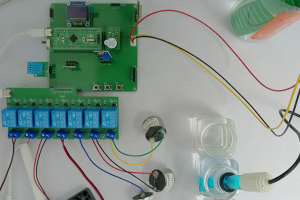设计说明书
总字数:22000+
摘要
随着家庭园艺的兴起,营养液培养作为一种高效的植物种植方式,其环境的稳定与精准调控对植物生长状态和成活率至关重要。传统的家庭植物培养管理依赖人工观察和手动调节,不仅耗费时间精力,还易因经验不足导致温湿度、光照、PH 值等参数控制不当,影响植物生长,难以满足现代化家庭对便捷化、智能化种植的需求。
基于 STM32F103C8T6 单片机的家庭植物营养液培养环境智能监测与远程控制系统,整合了 DHT11 温湿度传感器、5516 光照检测模块、SGP30 二氧化碳传感器、PH4502C 检测模块、YW-J 液位检测模块、3 个独立按键、OLED 显示屏、ESP8266WiFi 模块及执行设备(风机、加湿器、照明灯、CO₂发生装置、加酸 / 加碱装置、水泵等),实现了营养液培养环境的自动化监测与远程控制。系统核心功能包括:通过 DHT11 实时监测温湿度,温度超上限时启动风机并声光报警 3 秒,湿度低于下限时启动加湿器并声光报警 3 秒;借助 5516 光照检测模块,光照低于下限时自动开启照明灯并声光报警 3 秒;通过 SGP30 检测 CO₂浓度,浓度较低时启动 CO₂发生装置并声光报警 3 秒;利用 PH4502C 检测 PH 值,过高时加酸中和、过低时加碱中和,同时声光报警 3 秒;通过 YW-J 液位检测模块,水位较低时启动水泵抽水并声光报警 3 秒;支持通过 3 个独立按键设置参数阈值,手动控制各执行设备开关;通过 OLED 显示屏实时显示各项监测数据;借助 ESP8266WiFi 模块将数据上传至阿里云,实现手机端数据查看及远程控制各设备开关。
该系统的实现,有效提升了家庭植物营养液培养环境调控的自动化与智能化水平,减少了人工干预,确保了培养环境参数的稳定与精准,为家庭植物种植提供了高效、便捷的解决方案,同时为同类家庭园艺智能设备的研发提供了参考,具有较高的实际应用价值。
关键词:STM32F103C8T6;营养液培养;智能监测;远程控制;传感器;WiFi 通信
ABSTRACT
With the rise of home gardening, nutrient solution cultivation, as an efficient plant growing method, the stability and precise regulation of its environment are crucial to plant growth status and survival rate. Traditional home plant cultivation management relies on manual observation and manual adjustment, which not only consumes time and energy but also easily leads to improper control of parameters such as temperature, humidity, light, and PH value due to insufficient experience, affecting plant growth and failing to meet the needs of modern families for convenient and intelligent planting.
The intelligent monitoring and remote control system for the family plant nutrient solution cultivation environment based on the STM32F103C8T6 microcontroller integrates DHT11 temperature and humidity sensors, 5516 light detection modules, SGP30 carbon dioxide sensors, PH4502C detection modules, YW-J liquid level detection modules, 3 independent buttons, OLED displays, ESP8266WiFi modules, and executive devices (fans, humidifiers, lighting lamps, CO₂ generating devices, acid-adding/alkali-adding devices, water pumps, etc.), realizing automatic monitoring and remote control of the nutrient solution cultivation environment. The core functions of the system include: real-time monitoring of temperature and humidity through DHT11, starting the fan and sounding and lighting alarm for 3 seconds when the temperature exceeds the upper limit, starting the humidifier and sounding and lighting alarm for 3 seconds when the humidity is below the lower limit; with the help of 5516 light detection module, automatically turning on the lighting lamp and sounding and lighting alarm for 3 seconds when the light is below the lower limit; detecting CO₂ concentration through SGP30, starting the CO₂ generating device and sounding and lighting alarm for 3 seconds when the concentration is low; using PH4502C to detect PH value, adding acid for neutralization when it is too high, adding alkali for neutralization when it is too low, and sounding and lighting alarm for 3 seconds at the same time; through YW-J liquid level detection module, starting the water pump to pump water and sounding and lighting alarm for 3 seconds when the water level is low; supporting parameter threshold setting through 3 independent buttons, and manual control of each executive device switch; real-time display of various monitoring data through OLED display; uploading data to Alibaba Cloud with the help of ESP8266WiFi module, realizing mobile phone data viewing and remote control of each device switch.
The implementation of this system effectively improves the automation and intelligence level of the environmental regulation of family plant nutrient solution cultivation, reduces manual intervention, ensures the stability and accuracy of the cultivation environment parameters, provides an efficient and convenient solution for family plant cultivation, and also provides a reference for the research and development of similar home gardening intelligent equipment, with high practical application value.
Keywords: STM32F103C8T6; Nutrient solution cultivation; Intelligent monitoring; Remote control; Sensor; WiFi communication
目录
第 1 章 绪论
1.1 研究的目的及意义
1.2 国内外发展情况
1.3 本文主要研究内容
第2章 设计思路与方案论证
2.1 主要元器件选择
2.1.1 主控芯片选择
2.1.2 温湿度传感器选择
2.1.3 光照检测模块选择
2.1.4 二氧化碳传感器选择
2.1.5 PH 值检测模块选择
2.1.6 液位检测模块选择
2.1.7 按键模块选择
2.1.8 显示模块选择
2.1.9 WiFi 模块选择
2.2整体设计方案
第 3 章 硬件设计
3.1 主控电路模块
3.2 温湿度传感器电路
3.3 光照检测模块电路
3.4 二氧化碳传感器电路
3.5 PH 值检测模块电路
3.6 液位检测模块电路
3.7 显示模块电路
3.8 WiFi 模块电路
3.9 按键模块电路
3.10 执行设备驱动电路
3.11 声光报警模块电路
第4章 系统程序设计
4.1 编程软件介绍
4.2 系统主流程设计
4.3 独立按键
4.4 OLED显示流程设计
4.5 温湿度检测模块子流程
4.6 WiFi模块子流程设计
第 5 章 实物测试
5.1 整体实物测试
5.2 温湿度传感器功能测试
5.3 光照检测模块功能测试
5.4 二氧化碳传感器功能测试
5.5 PH 值检测模块功能测试
5.6 液位检测模块功能测试
5.7 WiFi 模块功能测试
5.8 按键设置与显示功能测试
5.9 声光报警模块功能测试
第 6 章 总结与展望
6.1 总结
6.2 展望
致谢
参考文献
附录
附录一:原理图
附录二:PCB
附录三:主程序
购买后可查看具体内容!

